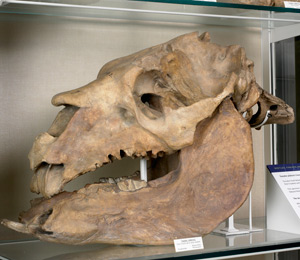Fossil vertebrates
 |
|---|
| A Toxodon skull. Courtesy of the University Museum of Zoology Cambridge. |
Darwin’s first notable discovery of large fossil mammal bones was made at Punta Alta in Patagonia towards the end of his first year aboard the Beagle. He wrote in his notes: ‘[T]he number of fragments of bones of quadrupeds is exceedingly great: – I think I could trace 5 or 6 sorts.’ Full understanding of the collection only came after the voyage once the fossils had been studied by specialists such as Richard Owen, however Darwin was struck at the time by the apparent similarities of extinct and living animals. He was also intrigued to discover some fossil horse teeth embedded in ancient remains, proving that the horse – previously believed to have been introduced to South America by the Spanish – had once existed there and become extinct. Among Darwin’s collections of fossils were significant specimens of Toxodon (a notoungulate sometimes described as a ‘giant guinea pig’), similar to the one on display in the University Museum of Zoology; these caused considerable consternation as they were difficult to reconcile with the accepted definition of mammals.

